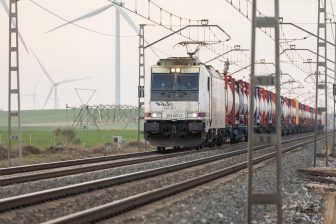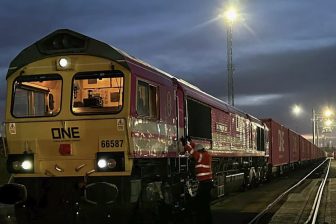
Solution for fire safety Rotterdam yard not in sight
A definitive solution for fire safety at the Rotterdam shunting yard of Waalhaven Zuid is not yet in sight. Dutch infrastructure manager ProRail says that after several failed tests, it has resumed to the design phase to find an adequate extinguishing provision on the busy Rotterdam freight yard. It is now looking at an operation date in early 2021.
Rail freight operators have been restricted to shunt wagons with dangerous goods at the emplacement yard since 13 September 2019. This was due to problems with the extinguishing facilities; a test proved that these facilities were not up to standard. The temporary closure has had a major impact on the industry, as operators had to relocate to other shunting yards to keep operations running.
Work around
The temporary fire existing procedures will remain in force until at least the beginning of next year, spokesperson Coen van Kranenbrug of ProRail explains to Nieuwsblad Transport, a sister publication of RailFreight. The main problem for rail operators on the Waalhaven Zuid railway yard is that wagons with dangerous goods may not be shunted for safety reasons, he explains.
“Logistically, we can work around the problems, thanks to agreements we made last year with rail freight operators and shippers. The situation means that users have to move to Kijfhoek and other yards in the port area for the time being.”
However, this solution does result in “higher costs for rail operators in a competitive market,” the spokesperson acknowledges. “In addition to carriers, other parties in the supply chain traffic control posts must also make additional efforts to ensure that freight transport runs safely.”
Compensation
For this reason, Prorail has set up a compensation scheme for affected customers, so that the extra costs incurred, such as hiring additional staff and longer use of locomotives, “do not hit them too hard”. In the “interest of customers”, ProRail does not want to state the exact amounts.
According to the railway manager, recent tests have shown that “the temporary system that we had developed with externally hired experts is not well enough to meet the requirements of the DCMR and Safety Region Rotterdam Rijnmond (VRR). That is why it was ultimately decided to look at a solution at Waalhaven South from scratch.
The focus is on a specific new safety regime for the Rotterdam railway yard in the first quarter of 2021. “A national solution must then be ready in 2023, in combination with modifications to the railway yard to enable longer and more trains. The final extinguishing system must fit into that concept. ”
Unruly
The first problems at Waalhaven Zuid date from mid-September 2019. At that time, DCMR and VRR requested ProRail to conduct an integral test of the deployment of the company fire brigade and the functioning of the extinguishing water supply. The test did not go well. The extinguishing water system was not adequate. Immediately, the railway manager stopped shunting dangerous goods.
The rail infrastructure company then started to look for alternatives. The construction of a temporary extinguishing system seemed the best option. The practice turned out to be more difficult, according to Van Kranenburg. “The system has never been built before and should be able to cover the entire marshalling yard under all circumstances. That is a huge challenge, especially because of the enormous amounts of water that have to be moved.”
A temporary system was installed at the end of October. The integrated test of that system, in early November, was also unsuccessful. For example, a hose was detached from a cuff and further tests had to be stopped.
Analysis
“We took the time because of this latest setback to properly analyse what went wrong and what possible solutions we had.” That resulted in a second test in January this year. This time, the extinguishing system appeared to function and VRR and DCMR gave the green light, but did impose some conditions. For example, ProRail had to carry out an extra test under extra high pressure (18 bar).
During that last test, on February 23, the installation turned out not to work. In total, ProRail has deployed about fifteen people in six months to technically solve the problems at Waalhaven South, says the spokesperson. “These people work under great pressure, for which we as an organisation greatly appreciate them. Unfortunately, it has not yet led to a working solution. ”
Deferred maintenance
Initially, the fire safety system on the Rotterdam railway yard was not maintained properly. ProRail is currently investigating who is ultimately responsible for this. “We take responsibility for the current situation and we are in constant consultation about improvements with both the carriers, the competent authority, the contractors, the national government and the regional and local authorities.”
The rail manager cannot yet say whether similar dangerous situations can also arise in other marshalling yards in the Netherlands. “There is certainly no emergency case. This was a serious nuisance for the freight transporters and other parties. We take the situation seriously and are also looking at other sidings in the Netherlands.”
National sidings project
Van Kranenburg continues: “With the lessons from Waalhaven, we must come to a good solution to get and keep the extinguishing facilities on the other yards in good order. In addition, with the so-called “national sidings project” we are trying to create a uniform facilities package for external safety on the marshalling yards in the Netherlands. This allows us to perform our management tasks better and it is also a lot clearer for the competent authority. The national sidings project is being carried out in collaboration with the Ministry of Infrastructure, local authorities, safety regions, transporters and us, among others. “




